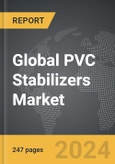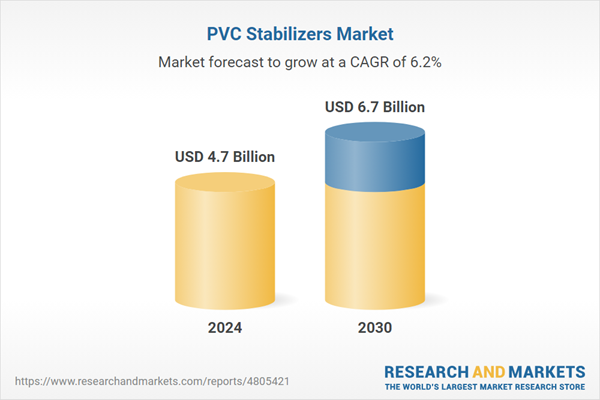The global market for PVC Stabilizers was valued at US$4.7 Billion in 2024 and is projected to reach US$6.7 Billion by 2030, growing at a CAGR of 6.2% from 2024 to 2030. This comprehensive report provides an in-depth analysis of market trends, drivers, and forecasts, helping you make informed business decisions. The report includes the most recent global tariff developments and how they impact the PVC Stabilizers market.
Segments: Type (Lead Stabilizers, Mixed Stabilizers, Tin Stabilizers, Organic Stabilizers); Application (Pipes & Fittings, Window Profiles, Rigid & Semi-Rigid Films, Wires & Cables, Coatings & Flooring, Other Applications).
Geographic Regions/Countries: World; United States; Canada; Japan; China; Europe (France; Germany; Italy; United Kingdom; Spain; Russia; and Rest of Europe); Asia-Pacific (Australia; India; South Korea; and Rest of Asia-Pacific); Latin America (Argentina; Brazil; Mexico; and Rest of Latin America); Middle East (Iran; Israel; Saudi Arabia; United Arab Emirates; and Rest of Middle East); and Africa.
The analysts continuously track trade developments worldwide, drawing insights from leading global economists and over 200 industry and policy institutions, including think tanks, trade organizations, and national economic advisory bodies. This intelligence is integrated into forecasting models to provide timely, data-driven analysis of emerging risks and opportunities.
Global PVC Stabilizers Market - Key Trends and Drivers Summarized
PVC Stabilizers: Ensuring Longevity and Stability of Polyvinyl Chloride Products
PVC stabilizers are essential chemical additives used to protect polyvinyl chloride (PVC) materials from degradation during processing and throughout their service life. Without stabilizers, PVC would be prone to thermal degradation when exposed to heat, leading to discoloration, loss of physical properties, and eventual failure of the material. Stabilizers work by neutralizing harmful byproducts that form during the processing of PVC, such as hydrochloric acid, which can catalyze further degradation. The most common types of PVC stabilizers include lead-based stabilizers, calcium-zinc stabilizers, tin stabilizers, and organic stabilizers. Each type offers specific advantages depending on the application, processing conditions, and regulatory requirements. For example, calcium-zinc stabilizers are widely used in applications where non-toxicity and environmental safety are paramount, such as in food packaging and medical devices. By ensuring the thermal stability and durability of PVC products, stabilizers play a crucial role in the material’s widespread use across various industries.How Are Technological Advancements Shaping the PVC Stabilizers Market?
Technological advancements have had a profound impact on the PVC stabilizers market, driving the development of more efficient, environmentally friendly, and high-performance stabilizers. The shift away from traditional lead-based stabilizers, due to health and environmental concerns, has led to the rise of alternative stabilizers such as calcium-zinc, barium-zinc, and organic-based systems. These alternatives offer comparable or superior performance while meeting stringent regulatory standards for safety and environmental impact. Advances in polymer chemistry have also enabled the development of stabilizers with improved heat resistance, UV protection, and color retention, extending the lifespan of PVC products in challenging environments. Additionally, the integration of multifunctional stabilizers, which combine heat stability with other properties such as lubrication or UV resistance, has streamlined the formulation process and improved the overall performance of PVC materials. These technological improvements are driving the adoption of advanced PVC stabilizers across various industries, contributing to the material’s continued dominance in global markets.What Are the Key Applications and Benefits of PVC Stabilizers in Industry?
PVC stabilizers are used in a wide range of applications, offering numerous benefits that enhance the stability, durability, and longevity of PVC products. In the construction industry, stabilizers are critical in the production of pipes, window profiles, and roofing membranes, where they ensure resistance to heat, UV radiation, and weathering. In the electrical and electronics industry, stabilizers play a key role in the production of insulation materials and cable sheathing, where thermal stability and flame retardancy are essential for safety and performance. The automotive industry relies on PVC stabilizers for the production of interior trims, dashboards, and seals, where resistance to heat and UV exposure is necessary to maintain product quality and appearance over time. Additionally, PVC stabilizers are used in the production of medical devices, food packaging, and toys, where non-toxicity and compliance with safety regulations are paramount. The primary benefits of PVC stabilizers include enhanced material stability, extended product lifespan, and the ability to customize PVC formulations for specific end-use applications.What Factors Are Driving the Growth in the PVC Stabilizers Market?
The growth in the PVC Stabilizers market is driven by several factors. The increasing demand for durable and long-lasting PVC products in construction, automotive, and electronics industries is a significant driver, as these sectors require materials that can withstand harsh environmental conditions and prolonged use. Technological advancements in stabilizer chemistry, particularly the development of non-toxic and environmentally friendly alternatives to lead-based stabilizers, are also propelling market growth. The rising adoption of PVC in medical and food packaging applications is further boosting demand for stabilizers, as these products require high levels of safety and regulatory compliance. Additionally, the expansion of infrastructure and construction projects in emerging markets is contributing to market growth, as PVC stabilizers play a critical role in ensuring the performance and longevity of building materials. The growing focus on environmental sustainability and the development of eco-friendly stabilizers are also supporting the adoption of advanced PVC stabilizers in various applications. These factors, combined with continuous innovation in stabilizer technology, are driving the sustained growth of the PVC Stabilizers market.Report Scope
The report analyzes the PVC Stabilizers market, presented in terms of units. The analysis covers the key segments and geographic regions outlined below.Segments: Type (Lead Stabilizers, Mixed Stabilizers, Tin Stabilizers, Organic Stabilizers); Application (Pipes & Fittings, Window Profiles, Rigid & Semi-Rigid Films, Wires & Cables, Coatings & Flooring, Other Applications).
Geographic Regions/Countries: World; United States; Canada; Japan; China; Europe (France; Germany; Italy; United Kingdom; Spain; Russia; and Rest of Europe); Asia-Pacific (Australia; India; South Korea; and Rest of Asia-Pacific); Latin America (Argentina; Brazil; Mexico; and Rest of Latin America); Middle East (Iran; Israel; Saudi Arabia; United Arab Emirates; and Rest of Middle East); and Africa.
Key Insights:
- Market Growth: Understand the significant growth trajectory of the Lead Stabilizers segment, which is expected to reach US$2.7 Billion by 2030 with a CAGR of a 6.9%. The Mixed Stabilizers segment is also set to grow at 5.2% CAGR over the analysis period.
- Regional Analysis: Gain insights into the U.S. market, valued at $1.2 Billion in 2024, and China, forecasted to grow at an impressive 10.4% CAGR to reach $1.6 Billion by 2030. Discover growth trends in other key regions, including Japan, Canada, Germany, and the Asia-Pacific.
Why You Should Buy This Report:
- Detailed Market Analysis: Access a thorough analysis of the Global PVC Stabilizers Market, covering all major geographic regions and market segments.
- Competitive Insights: Get an overview of the competitive landscape, including the market presence of major players across different geographies.
- Future Trends and Drivers: Understand the key trends and drivers shaping the future of the Global PVC Stabilizers Market.
- Actionable Insights: Benefit from actionable insights that can help you identify new revenue opportunities and make strategic business decisions.
Key Questions Answered:
- How is the Global PVC Stabilizers Market expected to evolve by 2030?
- What are the main drivers and restraints affecting the market?
- Which market segments will grow the most over the forecast period?
- How will market shares for different regions and segments change by 2030?
- Who are the leading players in the market, and what are their prospects?
Report Features:
- Comprehensive Market Data: Independent analysis of annual sales and market forecasts in US$ Million from 2024 to 2030.
- In-Depth Regional Analysis: Detailed insights into key markets, including the U.S., China, Japan, Canada, Europe, Asia-Pacific, Latin America, Middle East, and Africa.
- Company Profiles: Coverage of players such as Addivant, Akcros Chemicals Ltd., Akzo Nobel NV, Arkema Group, Baerlocher GmbH and more.
- Complimentary Updates: Receive free report updates for one year to keep you informed of the latest market developments.
Some of the 47 companies featured in this PVC Stabilizers market report include:
- Addivant
- Akcros Chemicals Ltd.
- Akzo Nobel NV
- Arkema Group
- Baerlocher GmbH
- BASF SE
- Clariant AG
- Patcham FZC
- Pau Tai Industrial Corporation
- Songwon Industrial Co., Ltd.
- Sun Ace Kakoh (Pte.) Ltd.
Tariff Impact Analysis: Key Insights for 2025
Global tariff negotiations across 180+ countries are reshaping supply chains, costs, and competitiveness. This report reflects the latest developments as of April 2025 and incorporates forward-looking insights into the market outlook.The analysts continuously track trade developments worldwide, drawing insights from leading global economists and over 200 industry and policy institutions, including think tanks, trade organizations, and national economic advisory bodies. This intelligence is integrated into forecasting models to provide timely, data-driven analysis of emerging risks and opportunities.
What’s Included in This Edition:
- Tariff-adjusted market forecasts by region and segment
- Analysis of cost and supply chain implications by sourcing and trade exposure
- Strategic insights into geographic shifts
Buyers receive a free July 2025 update with:
- Finalized tariff impacts and new trade agreement effects
- Updated projections reflecting global sourcing and cost shifts
- Expanded country-specific coverage across the industry
Table of Contents
I. METHODOLOGYII. EXECUTIVE SUMMARY2. FOCUS ON SELECT PLAYERSIII. MARKET ANALYSISCANADAITALYSPAINRUSSIAREST OF EUROPESOUTH KOREAREST OF ASIA-PACIFICARGENTINABRAZILMEXICOREST OF LATIN AMERICAIRANISRAELSAUDI ARABIAUNITED ARAB EMIRATESREST OF MIDDLE EASTIV. COMPETITION
1. MARKET OVERVIEW
3. MARKET TRENDS & DRIVERS
4. GLOBAL MARKET PERSPECTIVE
UNITED STATES
JAPAN
CHINA
EUROPE
FRANCE
GERMANY
UNITED KINGDOM
ASIA-PACIFIC
AUSTRALIA
INDIA
LATIN AMERICA
MIDDLE EAST
AFRICA
Companies Mentioned (Partial List)
A selection of companies mentioned in this report includes, but is not limited to:
- Addivant
- Akcros Chemicals Ltd.
- Akzo Nobel NV
- Arkema Group
- Baerlocher GmbH
- BASF SE
- Clariant AG
- Patcham FZC
- Pau Tai Industrial Corporation
- Songwon Industrial Co., Ltd.
- Sun Ace Kakoh (Pte.) Ltd.
Table Information
| Report Attribute | Details |
|---|---|
| No. of Pages | 247 |
| Published | April 2025 |
| Forecast Period | 2024 - 2030 |
| Estimated Market Value ( USD | $ 4.7 Billion |
| Forecasted Market Value ( USD | $ 6.7 Billion |
| Compound Annual Growth Rate | 6.2% |
| Regions Covered | Global |









